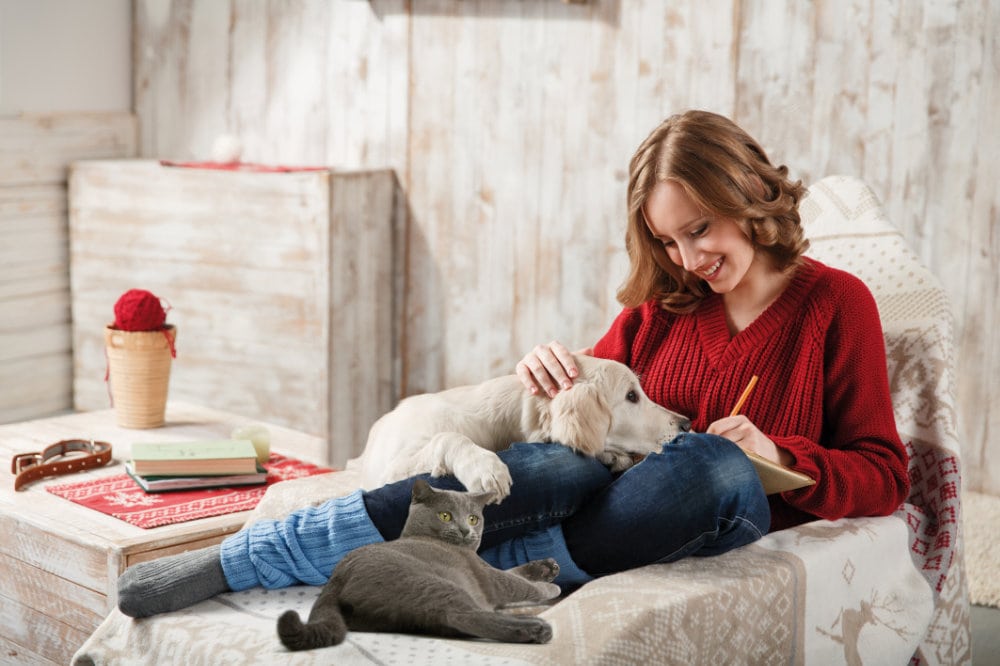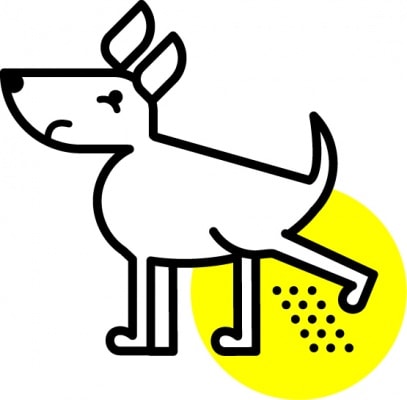Pheromones – what does it smell like?
Pheromones – what does it smell like?
Many owners of dogs and cats have experienced, or will experience, negative consequences of stress of their pet. It appears in a variety of ways: shivering, vocalisation, excessive licking, aggression, breaking furniture and objects, or urine marking. Dogs tend to show that they feel stressed, whereas cats are very sensitive to any changes in their environment and often cope with difficulties inwardly. In both cases, neglecting the problem of stress can worsen the condition of the animal. Therefore, it is worth making an effort to help the pet adapt and change its behaviour. However, you should remember that the owner is not left alone with the problem. There is a possibility to work with a behaviourist, or use aiding products available on the market that are composed of substances that have an effect on animal behaviour similar to pheromones.
Pheromones are complex mixtures of many different chemicals. The term ‘pheromone’ derives from Greek pherein, which means ‘to carry’, and horman, which means ‘to stimulate’. However, pheromones (which are released outside and are used mainly for communication, attraction, warning, etc.) should not be confused with hormones (which are produced by glands and are used to transmit information between organs)
Pheromones can be released by a human, animal or plant. The recipients of pheromones are usually members of the same species. Their function is to trigger a specific physiological or behavioural reaction. The “recipients” can sense them at minimal concentration and from a long distance, e.g. female pheromones of a bitch in heat. In terms of function, we have sedative pheromones, sex pheromones (attracting animals of the opposite sex), pheromones fighting against individuals of own or foreign species (antagonistic pheromones) and others. Some of them are responsible for warning communication, while others affect reproductive, territorial, social or maternity behaviour. Feline facial pheromones are a well-known example of sedative pheromones. They are released by cats when they rub their heads (chin, lips, whiskers and cheeks) against objects, furniture, the owner’s legs, etc. This way, the cat “leaves a message” that it feels good in a given environment. Another well-known example is the pheromone of lactating bitch. It is released by the tissues of the mammary gland and its main purpose is to calm the puppies during feeding. However, studies on pheromones show that this effect is also present in adult dogs.




What do pheromones smell like?
For the perception of pheromones, the main role is played by the vomeronasal organ, which is also called the Jacobson’s organ. This sensory organ is split into two and can be found near the vomer, inside the nasal cavity on both sides of the nasal septum. By licking or sniffing, animals transfer airborne chemicals to saliva, which in turn transfers them to the Jacobson’s organ. Contrary to the sense of smell, which requires recognition and identification of a previous experience (smell of a particular food, smell of a certain room at home or “the owner’s smell”), communication by means of pheromones does not have to be identified. Pheromones subconsciously induce a predictable effect on all individuals of the same species.
What is flehmen response?
The so-called flehmen response observed in cats consists in sucking air into the vomeronasal organ. By raising their upper lip with half-open mouth and moving their tongue, cats are able to detect the pheromones. During the flehmen response, due to the muscle contraction that forms the vomeronasal organ, its size changes, which leads to changes in internal pressure and air intake. Air molecules are mixed with the mucus that lines the organ and the fatty acids that form pheromones are combined with the binding proteins in order to stimulate the lining receptors of epithelium. Then the vomeronasal organ is cleansed by increasing blood pressure in the adjacent blood vessels. It is assumed that the vomeronasal organ can contain even more than 250 receptors.
Pheromone therapy for dogs
Separation anxiety disorder
Anxiety disorders are the main behavioural disorders of dogs and cats treated with pheromones. Separation anxiety disorder is a fundamental problem among anxiety disorders. According to world literature, as many as 40% of dogs suffer from it, which means that every third patient experienced it or is currently struggling with this problem. It should be emphasised that this is not a specific disease, but a syndrome of many, often very diverse symptoms, all of which result in fear or anxiety of a dog or cat. Behaviours typical for separation anxiety disorder include destructive behaviour, vocalisation, spinning around and catching invisible flies. However, there are also other symptoms of separation anxiety that may appear, including diarrhoea and vomiting, lack of appetite, too frequent urination or urinary retention, as well as psychologically motivated dermatoses. One of the main reasons for separation anxiety is excessive attachment of the animal to its owner. The second important cause is the impaired process of early socialisation (if at all). Unfortunately, there are some irresponsible breeders (or animal traders) who give away puppies or kittens aged 5–6 weeks, which greatly disrupts the adaptation processes. In such situations, treatment should include the modification of dog behaviour in combination with a change of owner’s attitude. Pheromones should be used as a support treatment. They help the owner to eliminate unwanted behaviours and help the animal to recover.
Phobias
Phobia is a strong feeling of fear in the presence of a certain stimulus, object or situation. In the case of dogs, we usually deal with fear of sounds, i.e. hypersensitivity to loud sounds, including storms and fireworks. This phenomenon is particularly acute during New Year’s Eve and New Year. Using preparations with substances that have the same effect as pheromones is obviously not fully sufficient in this situation, but it certainly constitutes a valuable supplement to the basic pharmacotherapy.
Improvement of daily comfort of life
Such preparations are also used during training because they help to consolidate the acquired knowledge and skills on the basis of positive associations. They also make it easier for your puppy to settle in a new home.
If your puppy has difficulty in adapting, i.e. withdraws, is restless, avoids contact, yelps at night – the use of preparations containing substances similar to animal pheromones allows for a smoother transition process.
If you bring a new animal into a house where animals are already present, we can also facilitate the process with the above mentioned preparations – in the case of resident animals or new members of the herd.
If your puppy does not handle the transport well, it is worthwhile spraying a special spray on the inside of the carrier a dozen or so minutes before the journey in order to calm the puppy down.
Also when visiting a veterinarian, it is worth spraying your hands with a preparation to make the pet feel more calm and confident.
During the holiday period, when we ask our friends to care for our pet or when we give them to the animal hotel, it is best to use an adaptation preparation in the form of a collar, which may help to soothe the emotions connected with separation.



The use of pheromones with cats
As is commonly known, cats are sensitive animals from a psychological point of view. They can show that they feel stressed in many different, often completely unusual ways. Chronic stress may result in the occurrence of, among other things, feline lower urinary tract disease, anorexia or, on the contrary, obesity or dermatological disorders (loss of hair caused by psychogenic factors), as well as excessive vocalisation.
One of the most troublesome behavioural disorders, in the course of which pheromone therapy may be helpful, is the feline psychogenic alopecia. However, it is often impossible to identify the specific cause of stress. Usually, it is related to the changes in the immediate environment of the animal, such as the appearance of a new householder, another four-legged pet, moving, changing the furniture, etc. Noise (music, fireworks, storm) and transporting the cat, e.g. for a veterinary visit, are also important stress-inducing factors.
In the case of cats, both those living alone and in a herd, the introduction of pheromones is a stimulus to increase activity and break “boredom,” which often leads to frustration and can lead to aggressive behaviour.
For some cats living in temporary homes, where increased animal migration is observed, the constantly changing structure of the herd is highly stressful for some individuals and in this case, the use of pheromones can restore their normal state and harmony.



Pheromones as a therapeutic measure
Preparations with substances having the same effect as pheromones are available on the market – in pet shops and clinics in the form of collars, sprays or diffusers.
Collars
Products of that type do not work immediately, it is a gradual process. The collar remains active for a specified number of days after unpacking, as declared by the manufacturer. It should be constantly worn by the animal. In order to achieve the best effect, the collar should be used in accordance with the instructions on the packaging. Collars are often used in cases where long-term therapy is required, e.g. in anxiety and adaptive disorders, or separation anxiety syndrome.
Sprays
Their use is, for obvious reasons, limited only to the area where they will be applied, e.g. the interior of a car or a carrier. Sprays are used on an ad-hoc basis, in specific situations, as needed, and also in cases where the use of collars is not possible or causes other inconveniences – especially when transporting animals or moving them to an unfamiliar place. Keep in mind that you should spray the corners of a room, carrier, car or a specific object, not the animal itself.
Diffusers
They have similar properties to sprays and collars. They are used in rooms where the animal is staying. It is important to read instructions so that a certain volume of the substance coming from the diffuser is used in a room with size that it is designed for.
Finally, it should be stressed that careful observation of the animal and its behaviour is very important. In many cases, the problem is partly due to ignorance of our four-legged companion behaviour and it becomes more acute with time.
Therefore, it is not worth waiting until problem becomes persistent. It is recommended to go to the behaviourist as soon as possible and use the preparations mentioned above.
Agnieszka Janeczek, veterinarian
animal behavioural disorders specialist (behaviourist)
Southampton University Anglia,
owner of the veterinary clinic “Cztery Łapy i Ty” in Wrocław
2 октября 2023




